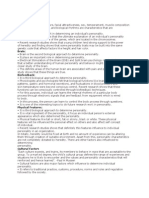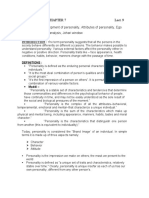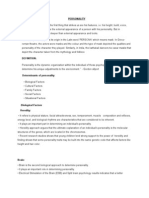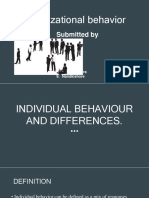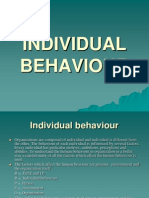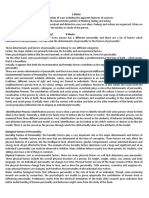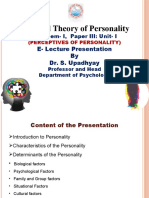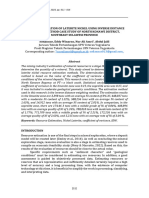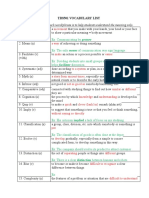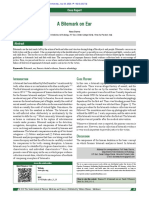Chapter-2
Organizational Behavior
Personality: Understanding Self & Others
1. 2. 3. 4.
Understanding Nature of Individuals. Concept of Hawthorne Studies. Theory X, Y & Z. Personality Determinants & Big Five Model and its application in organization. 5. SWOT Analysis Exercise
Personality & Its Determinants:
Personality refers to the relatively stable pattern of behaviors and consistent internal states that explains a persons behavioral tendencies. Personality has both internal and external elements. External traits are the observable behaviors that we rely on to identify someones personality. The internal states represent the thoughts, value, and genetic characteristics that we infer from the observable behaviors.
�Chapter-2
Organizational Behavior
-Determinants:
A. Biological Factors Cultural Factors Family Factors Social Factors Situational Factors
B. ENVIORNMENT FACTOR
A. Biological Factors Heredity: It refers to physical stature, facial attractiveness, sex, temperament, muscle composition and reflexes, energy level, and biological rhythms are characteristics that are considered to be inherent. It plays an important part in determining an individual's personality. Heredity approach argues that the ultimate explanation of an individual's personality is the molecular structures of the genes, which are located in the chromosomes. Recent research studies shows that young children lend strong support to the power of heredity and finding shows that some personality traits may be built into the same genetic code that affects factors like height and hair color. Brain: Brain is the second biological approach to determine personality. It plays an important role in determining personality. Electrical Stimulation of the Brain (ESB) and Split brain psychology results indicates that a better understanding of human personality and behavior might come from a closer study of the brain. The definite areas of the human brain are associated with pain and pleasure. Research study shows that these things are true. Biofeedback: It is third biological approach to determine personality. Physiologists and psychologists felt that biological functions like brainwave patterns, gastric and hormonal secretions, and fluctuations in blood pressure and skin temperature were beyond conscious control. Recent research shows that these functions can be consciously controlled through biofeedback techniques. For this purpose, individual can learns the internal rhythms of a particular
�Chapter-2
Organizational Behavior
body process through electronic signals that are feedback from equipment which is wired to body. In this process, the person can learn to control the body process through questions. It is one of the interesting topics to do future research work in personality. Physical Features: It is third biological approach to determine personality. It is vital ingredient of the personality, it focus an individual person's external appearance which also determined the personality. Physical features like tall or short, fat or skinny, black or white. These physical features will be influenced the personal effect on others and also affect self concept of individual. Recent research studies shows that definitely this features influence to individual personality in an organization. In totally, heredity would be fixed at birth and no amount of experience can be altering them through creation of suitable environment. Apart from this, personality characteristics are not completely dictated by heredity. There are other factors also influenced to determining personality. B. Environment Factors : Cultural Factors "Each culture expects, and trains, its members to behave in ways that are acceptable to the group. To a marked degree, the child's cultural group defines the range of experiences and situations he is likely to encounter and the values and personality characteristics that will reinforced and hence learned". -Paul H Mussen Cultural factors are also major factors which influence to determine individual personality. It refers to traditional practice, customs, procedure, norms and rules and regulation followed by the society. It significantly influence to individual behavior compare to biological factors. Cultural factors determine attitudes towards independence, aggression, competition, cooperation, positive thinking, team spirit, and a host of the human being and discharge his/her duties towards valuable responsibilities to society.
�Chapter-2
Organizational Behavior
Western culture influence to Indian society. It is best example of the cultural factors also determine the personality. Family Factors Family factors are also major factors which influence to determine individual personality. Family consists of husband and wife and their children's. Family role is very important for nurturing and personality development of their children. Family will be guided, supervised, take care of all family members, cooperation, 52 Organizational Behavior coordination and cooperation in work and also explained the role and responsibilities towards the family, society and real life. Family either directly or indirectly influence to person for development of individual personality. Social Factors Social factors are also major factors which influence to determine individual personality. It involves the reorganization of individual's in an organization or society. It refers to acquiring of wide range of personality by acquiring and absorbed by themselves in the society or an organization. Socialization process is starting from home and extending to work environment in an organization or society. It focuses on good relationships, cooperation, coordination and interaction among the members in the society or an organization or a family. In totally, environment factors consist of cultural factors, family factors, and social factors. Situational Factors Situational factors also influence to determine of personality. Situational factors are very important to change the individual behavior in a different circumstance at different situations, it also influence to personality of individual person. In general term, personality is stable and consistent and it does change in different situations. The Interaction of Personality and Situational Factors are outlined: Strong situational pressures Personality may not predict behavior
�Chapter-2
Organizational Behavior
Example: enforcement of rules Weak Situational pressures Personality may predict behavior Example: Customer sales representative A strong situation can overwhelm the effects of individual personalities by providing strong cues for appropriate behavior.
Theory X & Theory Y:
Douglas McGregor (1906 - 1964) is one of the forefathers of management theory and one of the top business thinkers of all time. McGregor developed a philosophical view of humankind with his Theory X and Theory Y in 1960. His work is based upon Maslow's Hierarchy of Needs, in that he grouped the hierarchy into lower-order needs (Theory X) and higher-order needs (Theory Y). He suggested that management could gain better results by the use of Theory Y,
�Chapter-2
Organizational Behavior
�Chapter-2
Organizational Behavior
Theory X Theory X assumes that the average person: -Dislikes work and attempts to avoid it. -Has no ambition, wants no responsibility, and would rather follow than lead. -Is self-centered and therefore does not care about organizational goals. -Resists change. -Is gullible and not particularly intelligent. Essentially, Theory X assumes that people work only for money and security.
Theory X - The Hard Approach and Soft Approach Under Theory X, management approaches can range from a hard approach to a soft approach. The hard approach relies on coercion, implicit threats, close supervision, and tight controls, essentially an environment of command and control. The soft appoach is to be permissive and seek harmony with the hope that in return employees will cooperate when asked to do so. However, neither of these extremes is optimal. The hard approach results in hostility, purposely low-output, and hard-line union demands. The soft approach results in ever-increasing requests for more rewards in exchange for everdecreasing work output. The optimal management approach under Theory X probably would be somewhere between these extremes. However, McGregor asserts that neither approach is appropriate because the assumptions of Theory X are not correct. Drawing on Maslow's hierarchy, McGregor argues that a satisfied need no longer motivates. Under Theory X the firm relies on money and benefits to satisfy employees' lower needs, and once those needs are satisfied the source of motivation is lost. Theory X management styles in fact hinder the satisfaction of higher-level needs. Consequently, the only way that employees can attempt to satisfy their higher level needs in their work is
�Chapter-2
Organizational Behavior
by seeking more compensation, so it is quite predictable that they will focus on monetary rewards. While money may not be the most effective way to selffulfillment, in a Theory X environment it may be the only way. Under Theory X, people use work to satisfy their lower needs, and seek to satisfy their higher needs in their leisure time. But it is in satisfying their higher needs that employees can be most productive. McGregor makes the point that a command and control environment is not effective because it relies on lower needs as levers of motivation, but in modern society those needs already are satisfied and thus no longer are motivators. In this situation, one would expect employees to dislike their work, avoid responsibility, have no interest in organizational goals, resist change, etc., thus making Theory X a self-fulfilling prophecy. From this reasoning, McGregor proposed an alternative: Theory Y.
Theory Y
The higher-level needs of esteem and self-actualization are continuing needs in that they are never completely satisfied. As such, it is these higher-level needs through which employees can best be motivated. Theory Y makes the following general assumptions: -Work can be as natural as play and rest. -People will be self-directed to meet their work objectives if they are committedto them. -People will be committed to their objectives if rewards are in place that address higher needs such as self-fulfillment. Under these conditions, people will seek responsibility. Most people can handle responsibility because creativity and ingenuity are common in the population. Under these assumptions, there is an opportunity to align personal goals with organizational goals by using the employee's own quest for fulfillment as the motivator. McGregor stressed that Theory Y management
�Chapter-2
Organizational Behavior
does not imply a soft approach. McGregor recognized that some people may not have reached the level of maturity assumed by Theory Y and therefore may need tighter controls that can be relaxed as the employee develops. Theory Y Management Implications If Theory Y holds, the firm can do many things to harness the motivational energy of its employees: -Decentralization and Delegation - If firms decentralize control and reduce the number of levels of management, each manager will have more subordinates and consequently will be forced to delegate some responsibility and making to them. -Job Enlargement - Broadening the scope of an employee's job adds variety and opportunities to satisfy ego needs. -Participative Management - Consulting employees in the decision making process taps their creative capacity and provides them with some control over their work environment. -Performance Appraisals - Having the employee set objectives and participate in the process of evaluating how well they were met. If properly implemented, such an environment would result in a high level of motivation as employees work to satisfy their higher level personal needs through there jobs.
William Ouchi - Theory Z:
Another theory which has emerged, and deals with the way in which workers are perceived by managers, as well as how managers are perceived by workers, is William Ouchi's "Theory Z". This theory speaks of an organisational culture which mirrors the Japanese culture in which workers are more participative, and capable of performing many and varied tasks. Theory Z emphasizes things such as job rotation, broadening of skills, generalization versus specialization, and the need for continuous training of workers (Luthans).
�Chapter-2
Organizational Behavior
Much like McGregor's theories, Ouchi's Theory Z makes certain assumptions about workers. Some of the assumptions about workers under this theory include: the notion that workers tend to want to build co-operative and intimate working relationships with those that they work for and with, as well as the people that work for them. - Also, Theory Z workers have a high need to be supported by the company, and highly value a working environment in which such things as family, cultures and traditions, and social institutions are regarded as equally important as the work itself. These types of workers have a very well developed sense of order, discipline, moral obligation to work hard, and a sense of cohesion with their fellow workers. - Finally, Theory Z workers, it is assumed, can be trusted to do their jobs to their utmost ability, so long as management can be trusted to support them and look out for their well being . One of the most important tenets of this theory is that management must have a high degree of confidence in its workers in order for this type of participative management to work. While this theory assumes that workers will be participating in the decisions of the company to a great degree, one author is careful to point out that the employees must be very knowledgeable about the various issues of the company, as well as possessing the competence to make those decisions. This author is also careful to point out, however, that management sometimes has a tendency to underestimate the ability of the workers to effectively contribute to the decision making process . But for this reason, Theory Z stresses the need for enabling the workers to become generalists, rather than specialists, and to increase their knowledge of the company and its processes through job rotations and continual training. In fact, promotions tend to be slower in this type of setting, as workers are given a much longer opportunity to receive training and more time to learn the intricacies of the company's operations. The desire, under this theory, is to develop a work force, which has more of a loyalty towards staying with the company for an entire career, and be more permanent than in other types of settings. It is expected that once an employee does rise to a position of high level management, they will know a great deal more about the company and how it operates, and will be able to use Theory Z management theories effectively on the newer employees.
�Chapter-2
Organizational Behavior






